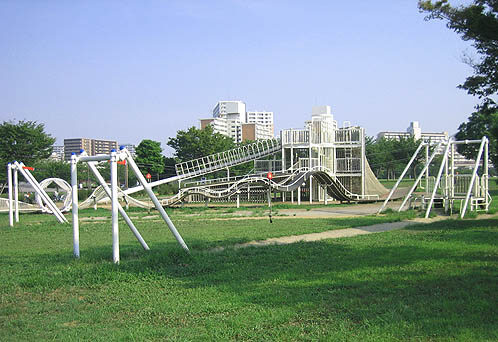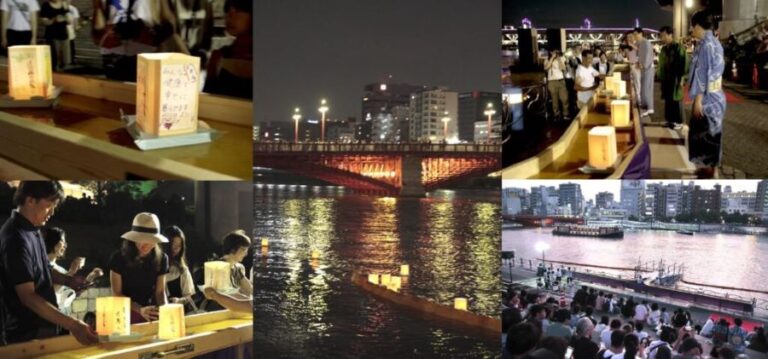The 2023 Fukagawa Festival Water throwing festival is back with a splash from August 11th to August 15th, bringing with it an incredible display of culture, tradition, and entertainment that should not be missed.
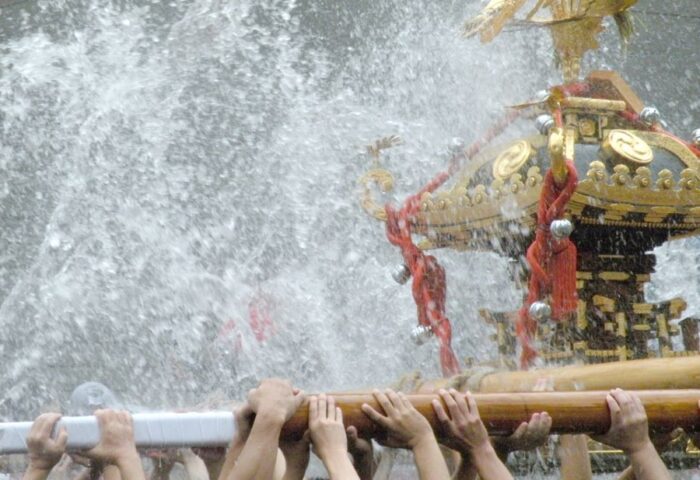
This iconic event given the moniker mizu-kake matsuri or water throwing festival is one of the 3 big Shinto festivals of Tokyo one of the more unique and exciting tokyo festivals. It is also a great way to cool off in the August heat!
About The Fukagawa Festival
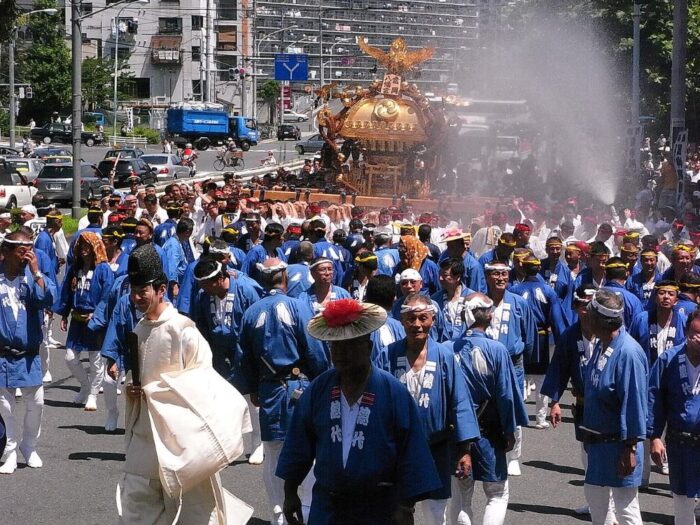
The festival, formally known as the Fukagawa Hachiman Festival is held in honor of the Tomioka Hachiman Shrine, and it’s one of the three great Shinto festivals of Tokyo. A cornerstone of the festival is the Mikoshi (portable shrine) parade, where 53 Mikoshi from different towns cover an 8 km route together, transforming the streets of Tokyo into a vibrant procession.
This year’s main event takes place in Miyamoto (Tomioka 1), right in the heart of the Hachiman precinct.
Festival Highlights and Events

Mikoshi Parade and Lantern Display
The festival begins on August 11th and 12th with select Mikoshi entering the shrine and a vibrant display of lanterns, known as Mantō Mikoshi, creating a spectacular sight as night falls.
The “Shinkōsai” Procession
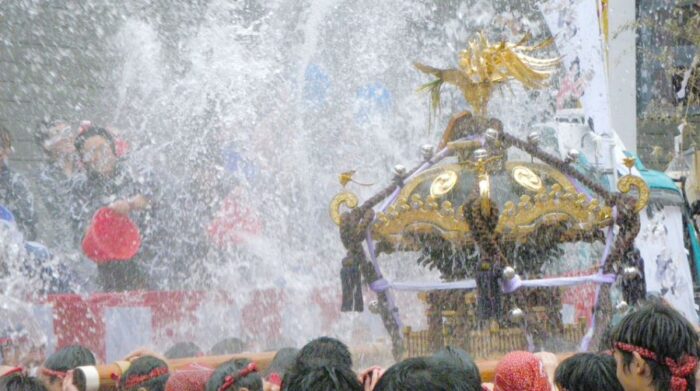
On August 12th, the “Shinkōsai” (procession of the deity) takes center stage. A phoenix-shaped palanquin is paraded around, covering an impressive 70 km route. The journey features twelve performances by Kagura dancers, creating a captivating spectacle for festival-goers.
Live Music Performances
Music enthusiasts will be treated to a jazz performance by The Dream Square Jazz Orchestra on August 11th, followed by the 24th annual Tomioka Hachiman Shrine Taiko Drum Festival. Traditional drumming and dance performances continue on the 12th and 13th, ensuring a lively atmosphere.
Japanese Performing Arts
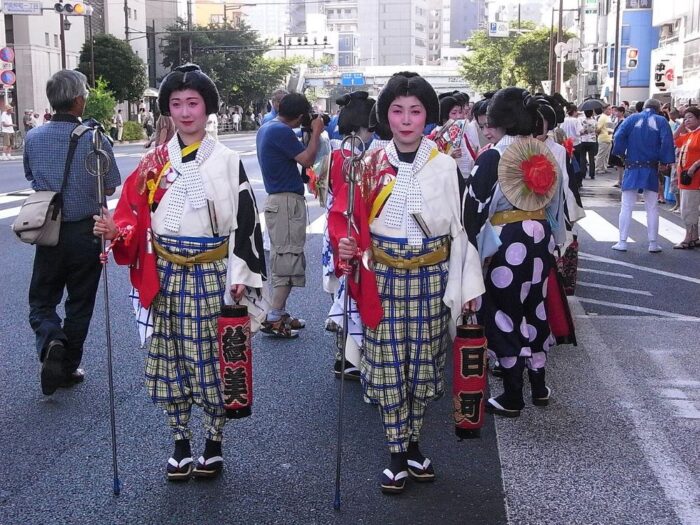
A variety of performances including Shaolin Kempo, traditional Japanese songs, and dance are scheduled throughout the event, offering festival-goers a glimpse into the rich world of Japanese performing arts.
Tea Ceremony
For a serene experience amidst the festival’s excitement, don’t miss the tea ceremony conducted by the Koto Ward Tea Flower Association on August 15th.
Practical Information for Visitors
All events are held in and around the Tomioka Hachiman Shrine, located in the Koto Ward of Tokyo. Though the festival is a free event, do bring some yen for food, drinks, and souvenirs.
Please note that schedules might change due to weather or other factors. For detailed information about the festival, make sure to check out the festival’s guide, “Wasshoi Fukagawa 2023”, available from July 10th.
2023 Fukagawa Hachiman Festival Schedule

August 11th (Friday)
- 15:00 – Jazz Performance by The Dream Square Jazz Orchestra
- 16:30 – The 24th Tomioka Hachiman Shrine Taiko Drum Festival
August 12th (Saturday)
- 08:00 – Shinkōsai (Phoenix Palanquin Procession) – Expected completion around 16:00
- 17:30 – Drumming and Dance Performance by Fukagawa Festival People
- 19:30 – Taiko Drum Performance by Aoi Taiko
August 13th (Sunday)
- 07:30 – Mikoshi Parade by All Towns (Expected arrival between 13:30-15:30)
- 09:00 – Morning Ritual Ceremony (Asamikesai)
- 14:00 – Traditional Song Performance by Yamazaki Akari
- 15:30 – Shaolin Kempo Performance by Fukagawa Dojo
- 18:00 – Shinto Music Performance by Iwami Kagura
August 14th (Monday)
- 09:00 – Morning Ritual Ceremony
- 11:00 – Worship by Revered Members
- 14:00 – Traditional Song Performance by Rinto Sisters
- 15:30 – Koto and Shamisen Performance by Ikuta School Peony Association
- 17:00 – Noh Stage by Fukagawa Noh Stage
- 19:00 – Dance Performance by Hosokawa Folk Dance Research Association
August 15th (Tuesday)
- 11:00 – Main Festival Ceremony
- 18:00 – Koto Performance by Yamaki Chika
- 18:00 – Tea Ceremony by Koto Ward Tea Flower Association
- 20:00 – Gamelan Music and Dance Performance by Fukagawa Baron Club
This schedule is subject to change based on unforeseen circumstances, so be sure to keep updated with any changes.
History Of The Festival

The Fukagawa Festival (Fukagawa Matsuri) is a traditional Shinto festival held annually around August 15 at the Tomioka Hachiman Shrine in Koto Ward, Tokyo. Also known as the “Fukagawa Hachiman Festival” and the “Water-throwing Festival,” it’s recognized as one of the “Three Great Festivals of Edo,” alongside the Kanda Festival and Sanno Festival. Its roots trace back nearly 380 years, to the Edo period.
Origins
The festival was instituted by the Tokugawa shogunate in 1642 when the third shogun, Tokugawa Iemitsu, celebrated his first son, Ietsuna, becoming his successor. This event laid the foundation for the festival, symbolizing the close ties it has with the Tokugawa shogunate and the Imperial household.
The Popularity Of The Water Throwing Festival

Every three years, a significant event known as Hon-Matsuri takes place, which is a spectacular parade of the Mikoshi (portable shrines) where the deities are carried from the shrine. The carriers chant “Wasshoi!” in unison, a lively cry that ripples through the neighborhoods. So popular has this event become that it was known to have caused a bridge to collapse due to the crowd’s size in 1807. This event also gives the festival its other name, the “Water-throwing Festival,” as bystanders splash water on the Mikoshi carriers to cool them in the summer heat.
In 1948, post-war Japan witnessed the festival’s first full-scale celebration. The Mikoshi was carried in front of the Imperial Palace to report the city’s recovery status. This practice of visiting the Imperial Palace was maintained in certain years, notably those of significance to the Imperial household.
The festival has evolved over the years, expanding to include more neighborhoods and incorporating new traditions. For example, the festival started a children’s Mikoshi parade in 2001. The Mikoshi from the Fukagawa Festival was invited to the “Iwate Golden Revival Festival” in Hiraizumi Town in 1995, signaling its widespread recognition.
The festival faced a significant setback in 2011, as the East Japan Earthquake resulted in the main festival being postponed to the following year. However, the spirit of unity prevailed as the Mikoshi from the Fukagawa Festival and the Kanda Festival were both participated in the “Great Earthquake Recovery Disaster Prevention Prayer Mikoshi Transfer Festival” as part of the Nihonbashi Bridge 100th anniversary festival. This action symbolized the nation’s resilience and unity in the face of adversity.
Today, the festival involves dozens of Mikoshi from different neighborhoods, parading an approximately 8-kilometer route that starts and ends at the Tomioka Hachiman Shrine, traveling through various districts of Koto Ward. This grand procession paints a vibrant picture of communal spirit and historical continuity, attracting spectators from around the world. The festival stands as a beacon of cultural heritage, a lively testament to Tokyo’s rich past, and a source of inspiration for its future.
The Sum Up

The Fukagawa Hachiman Festival is a perfect opportunity to cool off in the August heat and experience traditional Japanese culture with a vivid display of cultural performances and events.

